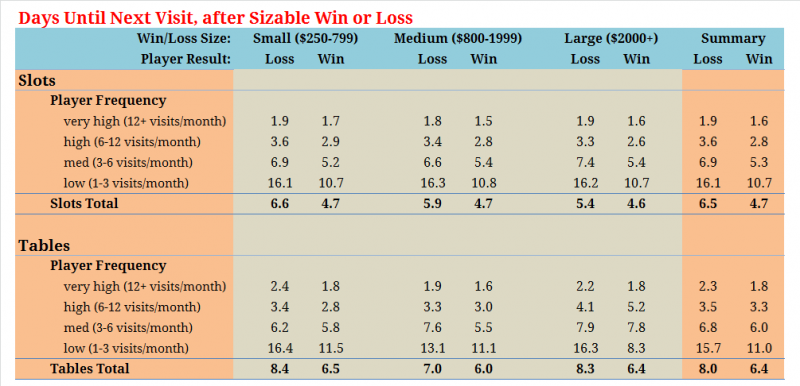How much of an impact does good luck play on your customers? Analytically, we choose to largely eliminate the impact of luck (because we can’t control it) by focusing on theoretical. But players don’t think about theo, they measure wins and losses by dollars. So does their wallet. Common sense would suggest that winning players are more likely to return to your property, first, because they feel lucky, and secondly, they have some extra money with which to gamble. So how do we check this hypothesis? How large is the impact?
This assumption was simple enough to test out — I looked at a sample of regular players (minimum of once per month) who had won or lost $250 in a single day, and then calculated how many days passed until their next visit. Not too surprisingly, players who won did in fact come back more quickly. Slot players who lost $250+ came back, on average, 6.5 days later. But those who won $250+ came back after just 4.7 days — nearly 2 days earlier.
I broke down the groups further — by the size of the loss, by the frequency of the player, and by slot vs tables. The entire table is below. The magnitude changes but the theme remains constant — winners return to your casino much faster than losers do. This result is probably not a huge surprise, but the overall impact is surprisingly large. Remember all the players in the sample are “regulars,” so we might assume they visit rain or shine, win or lose. Instead, these figures show their return can’t just be taken for granted.

Consider that 6.5 days between trips is 37% higher than 4.7 days. That’s a lot of extra trips, especially since these are already relatively frequent guests. Now, while we can’t magically create winners, we do have some control over the players’ experiences. Especially during lengthy periods without organic growth, executives start proposing raising hold percentages or lowering free play reinvestment. Both concepts are attempts to extract more profit per player-trip, and as such, they make it tougher for a player to have a winning trip. When these ideas get rolled out, it is assumed that squeezing a few extra dollars per customer per trip will improve profitability — but this only works if trip counts don’t decline. Usually that impact is ignored or assumed to be very low. Now we know it’s not so small. Certainly, raising holds by a tenth or two won’t affect all trips, so the trip decline won’t be anywhere near 37% — but it’s likely to be higher than anticipated.
** This analysis only measured trips where the player eventually returned to the property — any final trips were not included since “days until next visit” can’t be calculated. Therefore, trips that led a player to completely abandon aren’t included. One would imagine that’s more common after a losing trip, rather than a winning one. Therefore, the gap is likely to be slightly larger than what is reported.*

